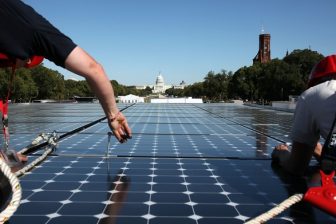
Almost 10 million children may never return to school after lockdown
Nearly 10 million children could be forced out of school forever because of education budget cuts and rising poverty brought on by the COVID-19 pandemic.
Save the Children also warns that millions more children could fall behind in their learning, with girls more likely to be much worse affected than boys, with many forced into early marriage.
A report by the charity says that as the impacts of the global recessions triggered by the pandemic start to bite, many children may also be pushed into forced labour. Save the Children is calling for governments and donors to respond to this emergency by urgently investing in education as schools begin to reopen after months of lockdown.
‘Unprecedented education emergency’
It is is also urging commercial creditors to suspend debt repayments by low-income countries – a move that could free up some US Dollars ($) 14 billion for investment in education.
Janti Soeripto, President and CEO of Save the Children, said: “It would be unconscionable to allow resources that are so desperately needed to keep alive the hope that comes with education to be diverted into debt repayments. Around 10 million children may never return to school – this is an unprecedented education emergency and governments must urgently invest in learning,”
“Instead, we are at risk of unparalleled budget cuts which will see existing inequality explode between the rich and the poor, and between boys and girls. We know the poorest, most marginalized children who were already the furthest behind have suffered the greatest loss, with no access to distance learning—or any kind of education—for half an academic year.”
‘Poorest children have suffered the greatest loss’
The agency calls for governments to use their budgets to ensure children have access to distance learning while lockdown measures remain, and to support children who have fallen behind.
The Save our Education report reveals the devastating effects the COVID-19 outbreak is set to have on learning. In a mid-range budget scenario, the agency estimates that the recession will leave a shortfall of $77 billion in education spending in some of the poorest countries in the world over the next 18 months. In a worst-case scenario, under which governments shift resources from education to other COVID-19 response areas, that figure could climb to an astonishing $192 billion by the end of 2021.
Before the outbreak, 258 million children and adolescents were already out of schooli. A Vulnerability Index in the report shows that in 12 countries, mainly in West and Central Africa but also including Yemen and Afghanistan, children are at extremely high risk of not returning to school after the lockdowns lift—especially girls ii.
‘I miss my school and my friends so much’
In another 28 countries, children are at moderate or high risk of not going back to school and of the longer-term effects of widening inequalities. In total, Save the Children estimates that some 9.7 million children could be forced out of school by the end of this year.
Save the Children highlighted the story of Aisha*, 15, from Ethiopia.
“Three months ago, things were very good for me,” she said. “I was enjoying school in grade six. When we were in school, we used to play with our friends and learn. The school also used to provide us with a meal every day. Now after this virus, I can’t go to school, and I can’t see my friends. I miss my school and my friends so much.
“It has been nearly three months since schools were closed and like many of the children here, I spend most of my time looking after the livestock and I sometimes help my mother with household chores like cleaning and cooking.”
Many of the top 12 countries in the report’s index already had high out of school rates and a sharp divide in school attendance along wealth and gender lines. These factors are likely to be exacerbated by school closures, with girls and children from poverty-stricken families being hardest hit.
‘Children caught in a vicious cycle of risk’
Children in these countries are also caught in a vicious cycle of risk: they face greater risks of being forced into child labor, and adolescent girls are especially at risk of gender-based violence, child marriage, and teenage pregnancy, which increases the longer they are out of school. The same risks directly impact their ability to return to school at all. Combined with the sharp decrease of education spending, the COVID-19 outbreak could be a cruel blow for millions of children.
In many countries, Save the Children has provided distance learning materials such as books and home learning kits to support learners during lockdown, working closely with governments and teachers to provide lessons and support through radio, television, phone, social media, and messaging apps.
Despite the efforts of governments and organizations, some 500 million children have had no access to distance learning, and many of the poorest children may not have literate parents who can help themiv. Having lost out on months of learning, many children will struggle to catch up, raising the likelihood of dropping out.
‘Impact on children’s futures will be long-lasting’
Save the Children warns that school closures have meant much more than education loss for many children, taking away safe places where children can play with friends, have meals, and access health services, including services for their mental health. Teachers are often front-line responders and protectors for children who might suffer from abuse at home. With school closures, these safeguards fall away.
“If we allow this education crisis to unfold, the impact on children’s futures will be long-lasting,” Soeripto added. “The promise the world has made to ensure all children have access to a quality education by 2030 will be set back by years.
“Governments should be putting the interests of children before the claims of creditors. Whether they live in a displacement camp in Syria, a conflict zone in Yemen, a densely populated urban area, or a remote rural village: all children have a right to learn, to develop, to build a better future than their parents might have had. Education is the basis for that, and we can’t afford to let COVID get in the way.”
Save the Children urges governments and donors to ensure that out-of-school children have access to distance learning and to protection services. Those who return to school should be able to do so in a safe and inclusive way, with access to school meals and health services. Learning assessments and catch-up classes must be adapted so that children can make up for their lost learning.
To ensure this happens, Save the Children is calling for an increased funding of education, with $35 billion to be made available by the World Bank. National governments must make education a priority by producing and implementing COVID-19 education responses and recovery plans to ensure the most marginalized children are able to continue learning.
Click here to download the report.
*Name changed




